Glymphatic pathway dysfunction in severe obstructive sleep apnea: A meta-analysis
IF 3.8
2区 医学
Q1 CLINICAL NEUROLOGY
引用次数: 0
Abstract
Background
Obstructive sleep apnea (OSA), a sleep disorder, is associated with cognitive decline and is potentially linked to glymphatic system dysfunction. This meta-analysis investigates glymphatic function in severe OSA (apnea-hypopnea index ≥30) using the Diffusion Tensor Imaging Analysis along the Perivascular Space (DTI-ALPS) index.
Methods
This study followed PRISMA guidelines for systematic reviews and meta-analyses. A comprehensive search of PubMed, Web of Science, Scopus, and Embase was conducted from inception to January 20, 2024. Studies investigating the ALPS index in OSA using DTI were included. Analyses included a random-effects meta-analysis, sensitivity analysis, meta-regression, publication bias evaluation (funnel plot, Egger's test, and Begg's test), and risk of bias assessment.
Results
Systematic review identified four studies (137 patients with severe OSA and 170 healthy controls (HCs)). Pooled analysis revealed a significant reduction in the DTI-ALPS index in severe OSA patients compared to HCs (standardized mean difference: −0.95, 95 % CI: −1.46 to −0.44, p < 0.001), indicating impaired glymphatic function. Heterogeneity was moderate to high (I2 = 76.07 %), but sensitivity analyses confirmed robustness. Meta-regression analyses identified the sources of heterogeneity as the apnea-hypopnea index (β = −0.039, p = 0.009) and the Epworth Sleepiness Scale (β = −0.150, p = 0.032), with no effects observed for age or male ratio. Qualitative (funnel plot) and quantitative publication bias assessments (Egger's and Begg's tests) showed no significant bias, and risk of bias evaluations using the Newcastle-Ottawa Scale indicated high methodological quality across studies.
Conclusions
These findings suggest that severe OSA disrupts glymphatic activity. The DTI-ALPS index emerges as a promising tool for assessing glymphatic dysfunction in OSA.
严重阻塞性睡眠呼吸暂停的淋巴通路功能障碍:荟萃分析
背景:阻塞性睡眠呼吸暂停(OSA)是一种睡眠障碍,与认知能力下降有关,并可能与淋巴系统功能障碍有关。本荟萃分析采用沿血管周围间隙弥散张量成像分析(DTI-ALPS)指数研究严重OSA(呼吸暂停-低通气指数≥30)患者的淋巴功能。方法本研究遵循PRISMA指南进行系统评价和荟萃分析。对PubMed, Web of Science, Scopus和Embase进行了全面的搜索,从成立到2024年1月20日。纳入了使用DTI研究OSA患者ALPS指数的研究。分析包括随机效应meta分析、敏感性分析、meta回归、发表偏倚评估(漏斗图、Egger检验和Begg检验)和偏倚风险评估。结果系统评价纳入4项研究(137例重度OSA患者和170例健康对照)。合并分析显示,与hc患者相比,严重OSA患者的DTI-ALPS指数显著降低(标准化平均差:- 0.95,95% CI: - 1.46至- 0.44,p <;0.001),表明淋巴功能受损。异质性为中高(I2 = 76.07%),但敏感性分析证实了稳健性。meta回归分析确定了异质性的来源为呼吸暂停低通气指数(β = - 0.039, p = 0.009)和Epworth嗜睡量表(β = - 0.150, p = 0.032),年龄或男性比例没有影响。定性(漏斗图)和定量发表偏倚评估(Egger's和Begg's检验)未显示显著偏倚,使用纽卡斯尔-渥太华量表进行偏倚评估的风险表明各研究的方法学质量较高。结论严重的阻塞性睡眠呼吸暂停可破坏淋巴细胞的活性。DTI-ALPS指数是评估OSA患者淋巴功能障碍的一种很有前景的工具。
本文章由计算机程序翻译,如有差异,请以英文原文为准。
求助全文
约1分钟内获得全文
求助全文
来源期刊

Sleep medicine
医学-临床神经学
CiteScore
8.40
自引率
6.20%
发文量
1060
审稿时长
49 days
期刊介绍:
Sleep Medicine aims to be a journal no one involved in clinical sleep medicine can do without.
A journal primarily focussing on the human aspects of sleep, integrating the various disciplines that are involved in sleep medicine: neurology, clinical neurophysiology, internal medicine (particularly pulmonology and cardiology), psychology, psychiatry, sleep technology, pediatrics, neurosurgery, otorhinolaryngology, and dentistry.
The journal publishes the following types of articles: Reviews (also intended as a way to bridge the gap between basic sleep research and clinical relevance); Original Research Articles; Full-length articles; Brief communications; Controversies; Case reports; Letters to the Editor; Journal search and commentaries; Book reviews; Meeting announcements; Listing of relevant organisations plus web sites.
 求助内容:
求助内容: 应助结果提醒方式:
应助结果提醒方式:


